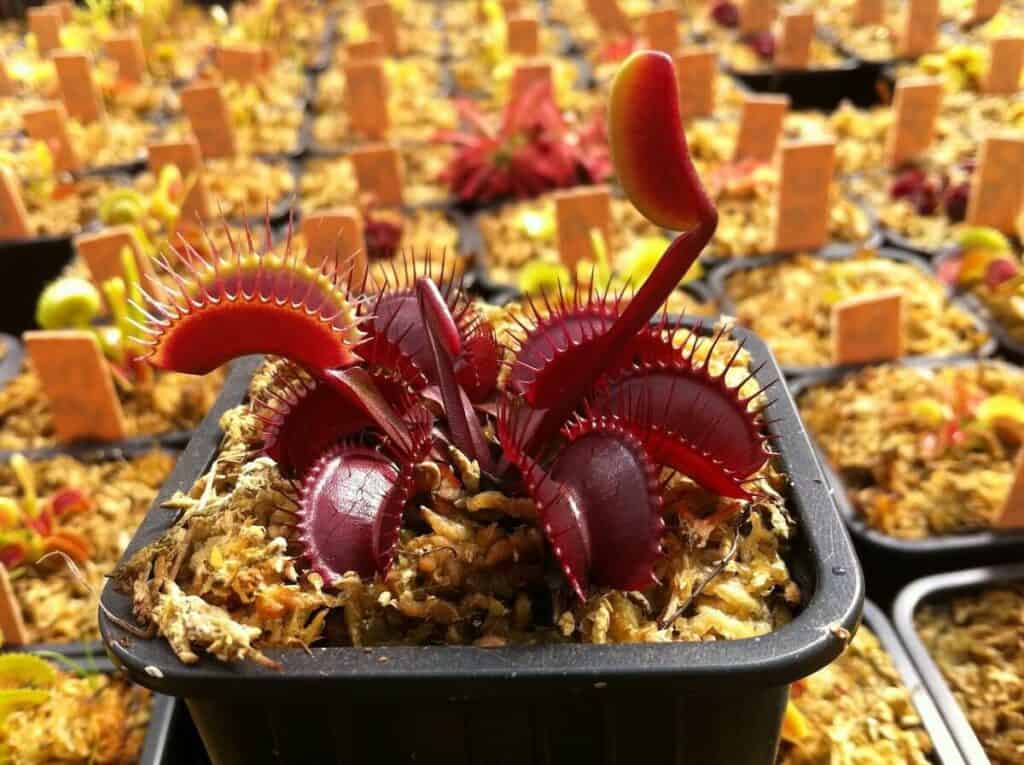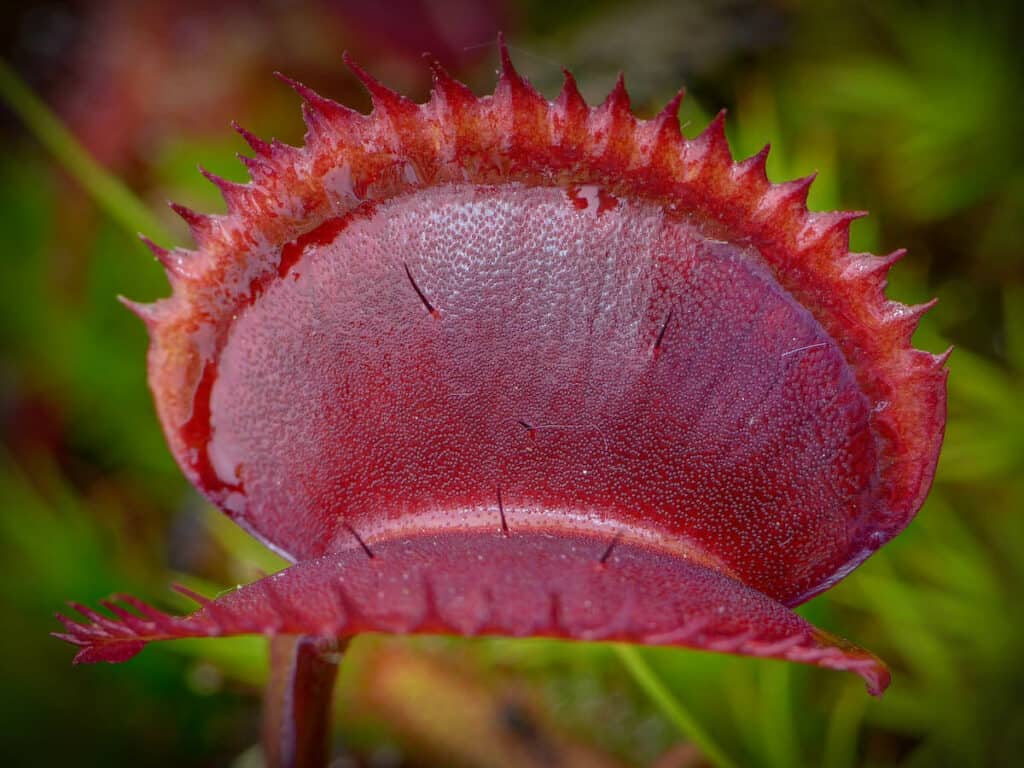Venus Flytraps are well-known for their beautiful vibrant green leaves shaped like jaws that feature a vivid red inside of the traps.
But did you know that there are also Venus Flytrap cultivars that have been developed in other colors, including a selection of beautiful bright red plants.
These striking flytraps will capture your attention not only for their carnivorous nature, but for their compelling and intense color.
In this article, we will take a look at the color red and the three red Venus Fly Trap varieties:
- Red Dragon Venus Flytrap
- All Red Venus Flytrap
- Red Piranha Venus Flytrap
We’ll also discuss what red means for the plant and what it means when there’s a lack of red.
Red Dragon Venus Flytrap (Akai Ryu)
The Venus Fly Trap Red Dragon (Dionaea muscipula) is named Akai Ryu, which means Red Dragon in Japanese. This is a striking and vigorous plant that features bright red stems with deep, burgundy-colored traps and is characterized by upright statuesque growth.
Color hues can vary from almost maroon to a lighter shade of red. The intense coloration is due to the generous quantity of anthocyanin contained in the plant, which is an organic red dye that the plant produces. Foliage is long and slender with traps that grow a bit larger than other cultivars.
The Atlanta Botanical Gardens introduced this particular Venus Flytrap in 1997. The cultivar was created by Ron Gagliardo, the curator of tropical plants for the Gardens. It was further propagated and distributed by them.
This red cultivar opened the door to the development of other red Venus Flytrap cultivars because it was used as a parent plant for breeding. The Akai Ryu Venus fly trap has since been registered and is officially recognized as a Venus Flytrap cultivar.
It can grow to heights of approximately four inches and does require access to full sunlight to maintain its intense red hue.
All Red Venus Flytrap (Dionaea muscipula “All Red”)

The Dionaea muscipula “All Red” is a handsome Venus Flytrap cultivar that boasts a deep maroon color when exposed to strong full sunlight. It is one of the darkest red-colored flytraps in existence.
As the plant receives greater amounts of light, its foliage will develop an increasingly darker red. This Venus Flytrap cultivar contains greater amounts of anthocyanin accounting for the intensity and darkness of its red coloring.
Red Piranha Venus Fly Trap (Dionaea Red Piranha)

Known botanically as the Dionaea Red Piranha, this Venus Flytrap is a clone hybrid. It is the result of crossbreeding between the Red Dragon Venus Flytrap and the Dionaea Dente.
Like a piranha, this the Red Piranha’s trap is quite fearsome in appearance. They have unique teeth that are shorter than those of other cultivars and bear a distinctive triangular shape.
In 1995, Edward Read of Hawthorne California received Venus Flytrap dentate seedlings from his friend Ivan Snyder. These seedlings originated from a Flytrap plant that had been chosen for cultivation years earlier by Leo Song, Jr. from among a group of collected wild Venus Flytrap plants.
These seedlings did not have red coloration though. In June of that year, Mr. Read cross-bred these plants with a red Venus Flytrap, thus beginning the development and propagation of the beautiful Venus Flytrap “Red Piranha” cultivar.
The Bright Red Color in Venus Flytraps
Leaves from a mature Venus Flytrap plant will generally show a bright red color. The coloring is due to large concentrations of red pigment contained in the plant’s digestive glands and the inner layer of foliage cells located inside traps.
The glands are not only red, but will secrete a red-colored sap when it is time to digest captured prey. Interestingly, this pigment is also found at the base of the trigger hairs that cause the trap to snap shut.
The Secret Behind the Red: Anthocyanin
The red pigment that gives the Venus Flytrap its bright red color is known as anthocyanin.
Anthocyanin is a flavonoid pigment, in blue, red, or violet that is commonly found in plants. Other examples include berries, some tropical fruits, some carrots, and dark-colored blue or purplish leafy vegetables.
The anthocyanin can even be extracted from plants and used in pharmaceuticals for a wide variety of health issues.
Traps should feature red unless you are raising an all-green cultivar. The red coloring together with the sweet nectar produced by the plant helps to attract prey to be captured for a nutritional boost.
Some Venus fly trap varieties never feature red coloring on the insides of traps regardless of light exposure. These are known as all-green cultivars such as the Dionaea Justina Davis. All-green Venus Flytraps are fewer and rarer.
Red Venus Flytrap clones require the same care as all other Venus Flytrap plants, including a proper growing medium, lots of very bright indirect light, and watering with distilled or rainwater.
When Venus Flytraps Lack Red Color
While some Venus Flytrap cultivars are totally red, there are a few that are completely green. When red coloring is lacking or a Venus Flytrap begins to lose its inner red coloring, this is usually due to a lack of sufficient light or in extreme cases, light starvation.
Venus Flytraps survive primarily thanks to nourishment procured through photosynthesis. If a plant does not receive adequate exposure to sunlight, it will forgo trapping insects to divert its energy to photosynthesis as a survival tactic.
Plants struggling to obtain sufficient nourishment will grow foliage that is entirely green without the characteristic red seen inside the traps.
To revive a Venus Flytrap that has lost the red within its traps, move it to a location with full bright sunlight. 12 hours of sunlight daily is ideal.
- Learn more about Venus Flytrap Lighting Needs in this in-depth guide.
Plants that need to be relocated should be gradually introduced to increasing amounts of light. Do not change lighting conditions radically from one day to the next.
If the environment does not offer window access granting sufficient light exposure, grow lights can be used to supplement your plant’s needs.
A lack of light will not immediately kill a plant but left as-is, the plant will weaken, hastening its demise.
Bright red traps are a sign of a healthy Venus Flytrap plant and are an essential tool for attracting and capturing insect prey. Plants located in proper lighting conditions with the occasional insect as a nutritional supplement will generally conserve their vibrant red and green coloring without difficulty.
Red Coloring in the Leaf Base
While some color changes are indicative of a healthy plant, some are, on the contrary, colored-related warning signs indicating a problem for your plant.
Should your Venus Flytrap begin to develop red spots or coloring at its leaf base, this indicates that your plant has been burned. Your Dionaea has most likely been exposed to extremely high heat.
Environmental temperatures that exceed 95° Fahrenheit can cause a Venus Flytrap to dry out and suffer burning and causing these spots.
Red Venus Flytraps Final Thoughts
All in all, red coloring is a beautiful trait found in many different types of Venus Flytrap plants. The fact that Flytraps have this unique coloring makes them even more attractive to gardeners and nature enthusiasts alike.
The red coloring serves as a visual indicator of health and vitality, making your plant stand out among others. The red coloring also acts as a natural attractant for insect prey. This helps ensure that your plant receives the nutrients it requires to thrive.
To learn more about these carnivorous plants, check out these articles:
Image sources:
- https:// commons.wikimedia.org/wiki/File:Red_Piranha._(14440517153).jpg
- https:// www.facebook.com/photo/?fbid=236580596374077




